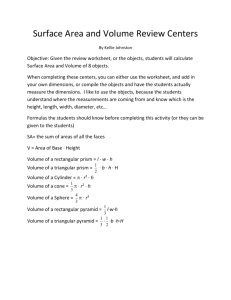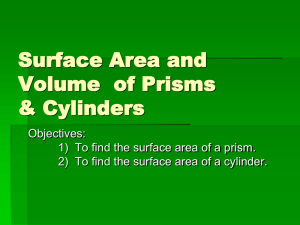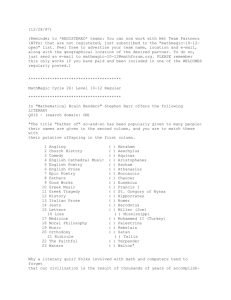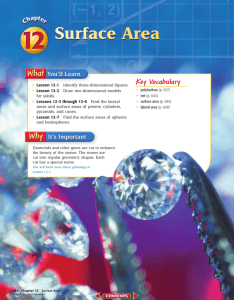Answer Key for Surface Area problems
advertisement
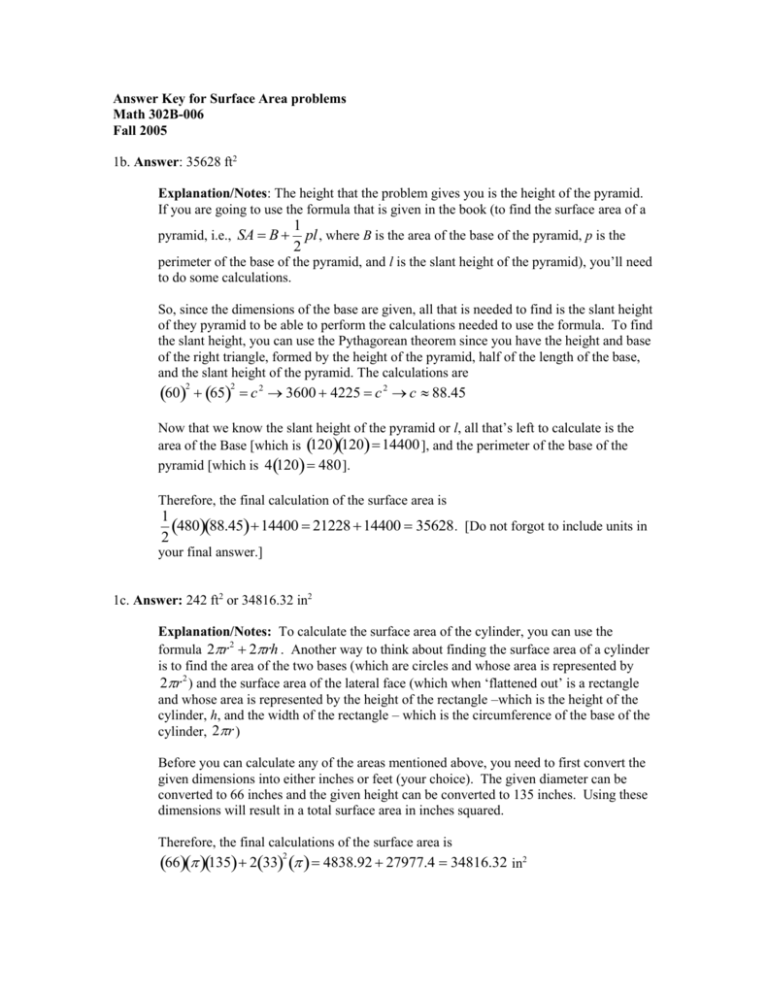
Answer Key for Surface Area problems Math 302B-006 Fall 2005 1b. Answer: 35628 ft2 Explanation/Notes: The height that the problem gives you is the height of the pyramid. If you are going to use the formula that is given in the book (to find the surface area of a pyramid, i.e., SA B 1 pl , where B is the area of the base of the pyramid, p is the 2 perimeter of the base of the pyramid, and l is the slant height of the pyramid), you’ll need to do some calculations. So, since the dimensions of the base are given, all that is needed to find is the slant height of they pyramid to be able to perform the calculations needed to use the formula. To find the slant height, you can use the Pythagorean theorem since you have the height and base of the right triangle, formed by the height of the pyramid, half of the length of the base, and the slant height of the pyramid. The calculations are 60 65 2 2 c 2 3600 4225 c 2 c 88.45 Now that we know the slant height of the pyramid or l, all that’s left to calculate is the area of the Base [which is 120120 14400 ], and the perimeter of the base of the pyramid [which is 4120 480 ]. Therefore, the final calculation of the surface area is 1 480 88.45 14400 21228 14400 35628. [Do not forgot to include units in 2 your final answer.] 1c. Answer: 242 ft2 or 34816.32 in2 Explanation/Notes: To calculate the surface area of the cylinder, you can use the 2 formula 2r 2rh . Another way to think about finding the surface area of a cylinder is to find the area of the two bases (which are circles and whose area is represented by 2r 2 ) and the surface area of the lateral face (which when ‘flattened out’ is a rectangle and whose area is represented by the height of the rectangle –which is the height of the cylinder, h, and the width of the rectangle – which is the circumference of the base of the cylinder, 2r ) Before you can calculate any of the areas mentioned above, you need to first convert the given dimensions into either inches or feet (your choice). The given diameter can be converted to 66 inches and the given height can be converted to 135 inches. Using these dimensions will result in a total surface area in inches squared. Therefore, the final calculations of the surface area is 66 135 233 4838.92 27977.4 34816.32 in2 2 To convert this value in to feet squared, you must remember to divide by 144 not 12, since 1ft 12in 144in 2 . Dividing 34816.32 in2 results in 242 ft2. 2 2 2b. Answer: 695.2 ft2 or 100108.8 in2 Explanation/Notes: Since this shape is a prism, you can use the formula given to find the total surface area of a prism or SA 2B ph , where B is the area of the base, p is the perimeter of the base, and h is the height of the prism. In order to use this formula, we will need to find the area of the base, the perimeter of the base, and the height of the prism. Once again, you will also need to convert the given units to either inches orto feet. I will convert them to inches. Converting the given units to inches, you will get 108 inches for the height of the prism, 105 inches for one of the lengths of the base of the prism, 148 inches for the other length of the prism, and finally 156 for the slant height of the base of the prism. To find the area of the base of the prism, you will need to find the area of a trapezoid, or 1 h(a b), where h is the height of the trapezoid and a and b are 2 the lengths of the base of the prism. We have a and we have b; what we do not have is h. To find h, we need to use the Pythagorean theorem, using the slant height of the trapezoid, ¼ of the length of the trapezoid, and the height of the trapezoid to form a right triangle. We have the slant height; to find the length of the base of the right triangle, you need to first divide the longer base of the trapezoid (148) by 4. This gives you 21.5 as the length of the base of the right triangle. Using the Pythagorean theorem, results in 21.5 b 2 2 156 24336 462.25 b 2 b 15.45 2 Now that we have all the required pieces of information, we can now calculate total surface area of the prism: 1 (15.45)(105 148) (105 148 156 156)(108) 100108.8 in 2 2 Again, if you would like to convert this answer to feet squared, you will need to divide this answer by 144 (see the explanation for this given for problem #1c). Doing this division, you would get 695.2 ft2. 3a. Answer: 1085 ft2 Explanation/Notes: The easiest way to calculate the total surface area of this object is to calculate the area of each of the individual pieces that make up the object. The two longer sides of the object can each be thought of as a rectangle adjoined with a trapezoid. Thus, you can find the area of each of the rectangles, find the area of each of the trapezoids, and add them together. The area of each of the rectangles is 20(8) = 160, but since there are 2 of them, you would double 160 to get 320. The area of each of the trapezoids is 1 10(8 4) 60, but since there 2 are 2 of them, you would double 60 to get 120. To get the area of the base, you multiply the length and the width and get 20(15)=300. To get the area of one of the sides, you multiply its length and width and get 15(8)=120. To get the area of the other side, you multiply its length and width and get 15(4)=60. The last calculation to make, before adding up the individual areas to get the total surface area, is the area of the angular base rectangle (the part that slants upward). When you do this you get 15(11)=165. Now adding up all the individual areas, 320+120+300+120+60+165, gives you the total surface area of 1085 ft2. 5. Answer: 137.16 cm2, but since the question asks for square millimeters, your final answer should be 13716 mm2. Explanation/Notes: What is given is the diameter of the base of the inner cylinder, the distance from the edge of the inner base to the edge of the outer base, and the height of both cylinders. To calculate this total surface area, you will need to calculate three areas: the area of the lateral face of the outer cylinder; the area of the lateral face of the inner cylinder; and the area of the ‘rim portion of the base” (i.e., the difference between the areas of the larger base and smaller base). To calculate the area of the lateral face of the outer cylinder, you need the height of the cylinder and the circumference of the larger base (see the explanation for problem 1c to see why these dimensions are necessary). These dimensions are 5.4 and 4 [the diameter of the larger base is 5.4 because you need to add 0.4 to 5 (the diameter of the inner base)]. Multiplying these values together gives 67.86. To calculate the area of the lateral face of the inner cylinder, you need the height of the cylinder and the circumference of the smaller base (see the explanation for problem 1c to see why these dimensions are necessary). These dimensions are 5 and 4 . Multiplying these values together gives 62.8. To find the area of the ‘rim portion of the base’, you need to find the difference of the area of the larger base and the area of the smaller base. Doing so results in 2.7 2.5 22.89 19.62 3.27 . Since we have 2 of these ‘rims’, we 2 2 need to multiply 3.27 by 2 and get 6.54. Adding up the quantities, 6.54+62.8+67.86, gives the answer of 137.16 cm2, but to get the final answer in mm2, you need to multiply this answer by 100 (using the same logic used in 1c). This gives the final answer of 13716 mm2.
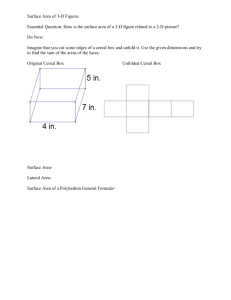
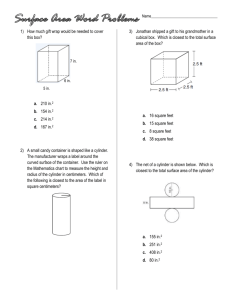



![Volume of Pyramids, Cones, and Spheres [12/4/2013]](http://s2.studylib.net/store/data/005724855_1-4c0eaf218975fc4d9fe792c18193e4dc-300x300.png)
